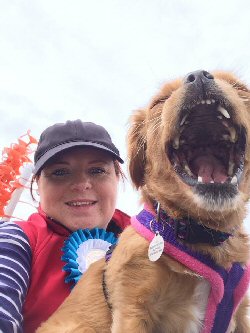Positive feedback and lots of lovely runs...
 Emily
Osborne passed her Kennel Club judging exams in early 2013. At the time, she
wasn't a particularly experienced handler but she wanted to give something back
to her beloved hobby. It was decision she hasn't regretted. She's now kindly
agreed to write this article to give those people who don't judge a bit more
insight into what goes into standing in the middle of the ring. Emily
Osborne passed her Kennel Club judging exams in early 2013. At the time, she
wasn't a particularly experienced handler but she wanted to give something back
to her beloved hobby. It was decision she hasn't regretted. She's now kindly
agreed to write this article to give those people who don't judge a bit more
insight into what goes into standing in the middle of the ring.
In order to judge at
Kennel Club shows, I was required to pass a written exam and a practical exam
with a KC accredited trainer but I've learnt so much more over the years I've
been judging. It's been a rollercoaster of emotions and experiences.
Although you don't
get paid, the perks such as free camping and petrol expenses, help to make what
can be an expensive hobby, just that little bit more affordable.
Judging is very hard work.
First you need to prepare your courses well in advance, and
designing them can take a long time, especially getting position and spacing
correct, and if you have a lot of different classes in one day.
Then you need to be
on site either very early but preferably the day before, to set up your course,
measure it, and maybe ensure it's up to scratch by running your own dogs round
it.
Physically it's
demanding, especially judging agility and running up and down the contacts up to
450 times a day.
And sometimes - which
really surprised me - it's very hard emotionally. You are responsible for making
some of the competitor's day absolutely brilliant. You're also potentially
responsible, whether you like it or not, for ruining someone's day, just because
you made a judging decision that perhaps they didn't agree with, or there was
something in the course they really hated. A very thick skin is required for
judging.
My first ever judging appointment
I was very lucky to have an experienced friend ring managing for me.
The first thing that happened to me after I had set up my agility course was a
competitor approaching me, complaining very aggressively about the positioning
of the seesaw. We moved it two inches to the left, which satisfied the
complainant, but I found this very hard to deal with at my first judging
appointment. I have since grown a thicker skin and realised that you are never
going to please everyone.
I don't think my
courses were brilliant when I started, and although I think they are much
improved now, but I don't always get it right! After all we are all merely
human.
Only a few weeks ago
another competitor was incredibly rude to me about one of my courses, but then a
very respected Champ handler told me how much they enjoyed the very same course.
On the plus side, there are many, many more occasions where I get lovely remarks
from competitors. and it's brilliant to see handlers doing well on a course -
I've even been hugged by a few who've had their first clear or a really exciting
win.
I love judging
Despite the ups and downs, I thoroughly recommend it for the agility
addicts amongst us. I love seeing you guys tackling the challenge I've set,
seeing the different handling styles, seeing an amazing clear round, seeing
people interacting with their dogs and rewarding them at the end of the run. I
love working with and meeting new people, I love happy dogs, and most of all I
love it when the sun shines!
But don't forget, all
judges have worked hard to be standing in that ring and they are trying their
very best. A lot of us have other commitments. For instance, I have a full time
job and two very young sons at home. So try and enjoy your run with your dog. If
it doesn't go how you had hoped, take a little bit of the rough with the smooth,
and remember, as a good friend of mine says, don't complain, go home and train!
About the author...
Emily Osborne has been training her Small crossbreed dogs
Honey (G6) and Guinness (G7) in agility with Wilmslow DTC for six years.
She works as a civil
servant and lives in Stockport, Greater Manchester with her husband Aaron and
two young sons, Reuben (14 months) and Rowan (5 years) who has just started
agility with Honey.
First published 18
October 2017
|